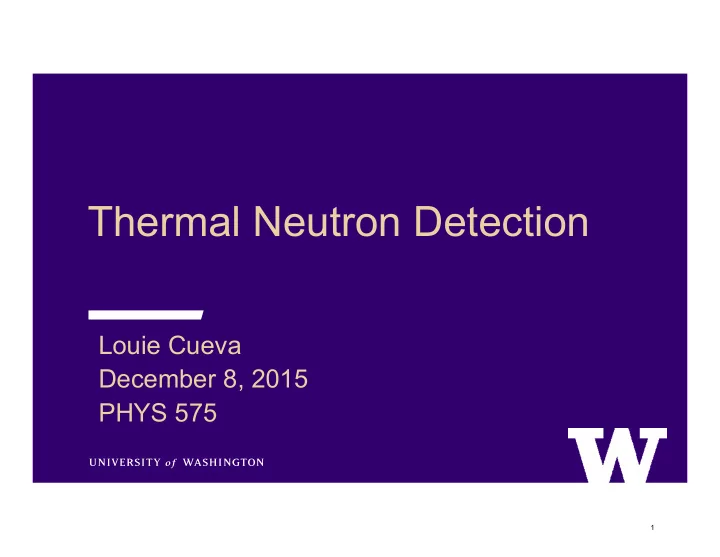

Thermal Neutron Detection Louie Cueva December 8, 2015 PHYS 575 1
Neutrons • 1932 – Chadwick discovered the neutron • No charge, No Coulomb force, No Service! • Interaction with detectors • Interactions with nuclei • ~10 min life time (free neutron) Fig 1. Chadwick (nobelprize.org) • Sources • Nuclear Reactors, Spallation (accelerator based), Fusion sources (D-T), Radioactive decay ( 252 Cf, 250 Cm, 240 Pu) • Applications • Nuclear, material science, imaging, medical physics 2
Neutron Energy Ranges INTERACTIONS < 0.005 eV Cold Diffraction 0.025 eV Thermal 0.02 eV Epithermal Capture Elastic ( η , γ )( η ,p)( η , α ) Scattering 1 – 10 eV Slow Fission ( η ,f) 300 eV ‐ 1 MeV Intermediate 1 – 20 MeV Fast Inelastic > 20 MeV Ultra Fast Scattering ( η , χ ) 3
Interaction with Matter Extremely weak electromagnetic interactions Radiation Protection Penetration through matter • Shielding is more complicated Nuclear interactions only, low probability at that • Interaction is inversely proportional to energy It’s about probability, not density • Atypical materials: paraffin, borated materials (concrete, water, polyethylene) Fig 2. Neutron Interaction (explorcuriosity.org) 4
Neutron Cross Section • Cross section is measure of the probability for a reaction between particles “Barn” has area dimensions (10 -28 m 2 ) • • Microscopic – probability of reaction between neutron and nucleus • Macroscopic – probability of interaction between neutron and material • Typical reactions Fig 3. neutron reactions (nucleonica.net) 5
Neutron Detection Cross Section vs. Energy • Cross section goes down as energy increases so slow neutrons (thermal) have a vastly different detection scheme than fast neutrons • Moderator material is used to slow neutrons down thereby generally increasing detection efficiency (to an extent…) • Fast Neutron spectroscopy allows for detection to quantify incoming neutrons and deduction of incoming neutron energy. • Thermal neutrons allow for greater chances of interaction, producing secondary (charged) particles. 6
Fig 4. elastic scattering (www.hep.umn.edu) Neutron Detection Elastic Scattering Max Energy Transfer • Light nuclei scattering is most common method for fast neutron Target Nucleus A E R /E N detection. 1 H 1 1.0 • Collision results in a recoil nucleus 2 H 2 0.89 that (in the case of H) can transfer between 0-100% of incident 3 He 3 0.75 neutron energy 4 He 4 0.64 • Recoil nucleus behaves like a proton or alpha particle for 12 C 12 0.28 detection purposes 16 O 16 0.22 7
Neutron Detection Capture / Absorption Fig 5. radiative capture (www.hep.umn.edu) • Radiative capture – absorbs η , emits γ . • Transmutation – absorbs η and emits p or α . • Important for radiation protection and reactor physics • Shielding/Attenuation/Moderation • Material to slow • Material to absorb • E.g. Boron, Cadmium, Gadolinium Fig 6. transmutation (www.hep.umn.edu) 8
Why Thermal Neutrons? Single Event Effects Testing • Cosmic and Atmospheric Neutrons • Primary radiation (100s of GeV for cosmic rays) • Spacecraft and high energy accelerator environments • LANSCE/WNR & TRIUMF (800 MeV & 500 MeV) • Thermal to 14 MeV Neutrons • Produced by fission, fusion, and weapons Fig 7. neutron induced upset (eetimes.com) • Borophosphosilicate glass (BPSG), SRAM FPGA 9
Safety First Radiation Protection • People are excellent moderators! • Regulatory limits & Q factors for absorbed dose • Absorbed dose equivalent dose effective dose Type of Radiation Quality Factor (W R ) X ‐ ray, gamma, beta 1 Alpha 20 Thermal neutrons (0.025 eV) 2 Fast Neutrons (1 – 20 MeV) 11 ‐ 6.5 Fig 8. neutron meters (ludlums.com) 10
Thermal Neutron Detection Spherical Cow • Large cross section so the detector can be small • Target material should be abundant and cheap • Discriminate gamma from neutron radiation • High Q-value • Reaction products captured by the detector • Recoil nucleus, proton, alpha particle, fission fragments • Nice clean full-energy peak 11
Thermal Neutron Detection Reality • 10 B ( η , α ) reaction • 6 Li ( η , α ) reaction • 3 He ( η ,p ) reaction • Neutron induced fission reactions Fig 9. neutron energy (iopscience.iop.org) 12
References [1] Dyer, C., Hands, A., Ford, K., Frydland, A., & Truscott, P.(2006). Neutron-Induced Single Event Effects Testing Across a Wide Range of Energies and Facilities and Implications for Standards. IEEE Transactions on Nuclear Science , 53(6), 3596-3601. doi:0.1109/TNS.2006.88627 [2] Knoll, G. (2010). Radiation Detection and Measurement (4 th ed.). New York: Wiley. [3] Shleien, B., Slaback, Jr., L., & Birky, B. K. (1998). Handbook of Health Physics and Radiological Health (3 rd ed.). Maryland: Lippencott Williams & Wilkins [4] Hamilton, D. (2006). Neutron Interactions with Matter. European Commission Institute for Transuranium Elements . Sept. 14, 2006 13
Recommend
More recommend